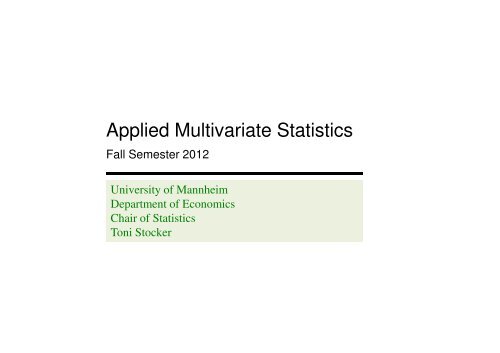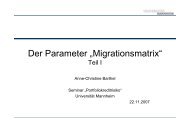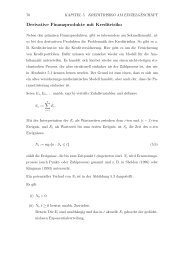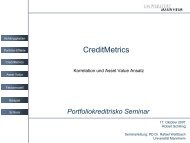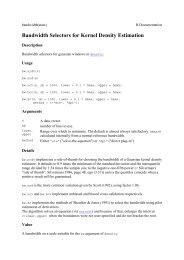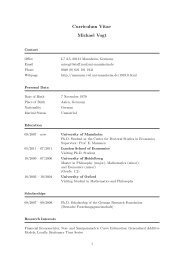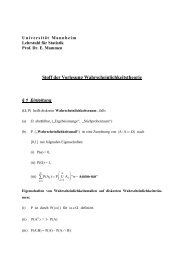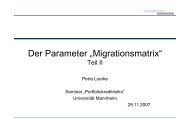Applied Multivariate Statistics
Applied Multivariate Statistics
Applied Multivariate Statistics
You also want an ePaper? Increase the reach of your titles
YUMPU automatically turns print PDFs into web optimized ePapers that Google loves.
<strong>Applied</strong> <strong>Multivariate</strong> <strong>Statistics</strong><br />
Fall Semester 2012<br />
University of Mannheim<br />
Department of Economics<br />
Chair of <strong>Statistics</strong><br />
Toni Stocker
Prerequisites<br />
General Course Information<br />
● Students in Economics from Mannheim: no problem<br />
● All other students:<br />
should have attended two or more courses in <strong>Statistics</strong><br />
(descriptive statistics, estimating and hypothesis testing)<br />
● A course in Basic Econometrics is helpful but not strictly required.<br />
● The statistical software R will intensively be used throughout this<br />
course. Students who are not yet familiar with R should work<br />
through chapters 1-5 of the R introduction (see course folder) on<br />
their own by September 14 at the latest.<br />
● If you are not yet sure whether you will attend this course, you may<br />
read sections 1.1 and 1.2 in Johnson & Wichern (see p. 3) to get an<br />
idea about the purposes of this course.<br />
Though R is easy to learn, you need to invest some time at<br />
the beginning. But you may benefit from it for a long time.<br />
1
Times and Locations<br />
Contact<br />
General Course Information<br />
Day Time Location<br />
Lecture Friday 10:15-11:45 L7, 3-5, P043<br />
Tutorial Friday 08:30-10:15 L7, 3-5, P043<br />
Tutorials start in the 2nd week.<br />
Office Hour: Wednesday, 3:30-5:00 p.m. or by appointment<br />
Office: L7, 3-5, 1st floor, room 143<br />
Phone: 0621-181-3963<br />
Email: stocker@rumms.uni-mannheim.de<br />
2
Course Material<br />
General Course Information<br />
Slides (Lecture), Assignments (Tutorials), ‘Introduction to R’ (see p. 1)<br />
Material will be updated weekly (Friday) to find in course folder<br />
at Studierendenportal (ILIAS)<br />
References<br />
● R. Johnson, D. Wichern (2007):<br />
<strong>Applied</strong> <strong>Multivariate</strong> Statistical Analysis; Pearson Intl. Ed.<br />
● A. Rencher (2002):<br />
Methods of <strong>Multivariate</strong> Analysis; Wiley.<br />
● W. Härdle, L. Simar (2003):<br />
<strong>Applied</strong> <strong>Multivariate</strong> Statistical Analysis; Wiley.<br />
● A. J. Izenman (2008):<br />
Modern <strong>Multivariate</strong> Statistical Techniques; Springer.<br />
● P. Hewson (2009):<br />
<strong>Multivariate</strong> <strong>Statistics</strong> with R; Open Text Book.<br />
Main Reference<br />
3
Exam + Assignments:<br />
80% written exam (120 minutes) + 20% Assignments<br />
in terms of points to earn in total.<br />
Example:<br />
Points<br />
Written Exam: 60 (from 80)<br />
Assignments: 18 (from 20):<br />
Total: 78 (from 100)<br />
Examination<br />
=> Grading will be based on 78 points (from 100)<br />
Minimum for passing: ≤ 40. Minimum for best grade (1.0): ≤ 95<br />
Assignments:<br />
Need to submit homework and attend tutorial. To get full points (20) you<br />
need to work at least on 10 assignments (out of 11) in a meaningful way.<br />
(See Guidelines for Assignments)<br />
4
What is it about?<br />
Issues of <strong>Multivariate</strong> Statistical Analysis<br />
<strong>Multivariate</strong> analysis consists of a collection of methods that can be<br />
used when several measurements are made on each individual or<br />
object in one or more samples. See Renchner (2002), p.1<br />
Objectives<br />
● Data reduction or structural simplification<br />
● Sorting and grouping<br />
● Investigation of the dependence among variables<br />
● Prediction<br />
● Hypothesis construction and testing<br />
See J+W (2007), p.2<br />
5
Example 1: Modern Graphical Techniques<br />
What is it about?<br />
6
Example 1 ...<br />
What is it about?<br />
7
What is it about?<br />
Example 2: Body Measures (Discrimination)<br />
8
What is it about?<br />
Example 3: US Arrests (Dimension Reduction)<br />
9
Example 4: US Arrests (Grouping)<br />
What is it about?<br />
10
Example 5: Hair and Eye Color<br />
Eye<br />
Hair Brown Blue Hazel Green<br />
Black 68 20 15 5<br />
Brown 119 84 54 29<br />
Red 26 17 14 14<br />
Blond 7 94 10 16<br />
What is it about?<br />
11
What is it about?<br />
Example 6: Distances (Dimension Reduction)<br />
12
Course outline<br />
What is it about?<br />
Generally: Chapters 1-4, 8, 9, 11, 12 from Johnson and Wichern (J&W)<br />
Timetable and Contents<br />
● Lecture 1: Introduction (today)<br />
● Lecture 2: Matrix Algebra (part 1)<br />
● Lecture 3: Matrix Algebra (part 2)<br />
● Lecture 4: <strong>Multivariate</strong> Samples<br />
● Lecture 5: Principal Component Analysis<br />
● Lecture 6: Factor Analysis<br />
● Lecture 7: Biplots<br />
13
Course outline ctd.<br />
● Lecture 8: Multidimensional Scaling<br />
● Lecture 9: Cluster Analysis<br />
What is it about?<br />
● Lecture 10: Linear Discriminant Analysis<br />
● Lecture 11: Binary Response Models<br />
● Lecture 12: Further Topics (e.g. Correspondence Analysis, CART, ...)<br />
● Lecture 13: Used as time buffer<br />
Note: This is just a plan! Topics may be skipped;<br />
order may be changed<br />
14
Main Objectives<br />
... at the end of the semester you<br />
What is it about?<br />
● know and (hopefully) understand most common methods for<br />
analyzing multivariate data and their theoretical background<br />
● can proficiently use R when using multivariate techniques:<br />
data import, constructing graphics, inference, model diagnosis<br />
and assessment<br />
● have experienced the possibilities and limitations of<br />
multivariate methods on the basis of real data examples<br />
Generally: This is an introductory and applied course.<br />
Modern multivariate techniques based on machine<br />
learning algorithms will hardly be covered.<br />
15


